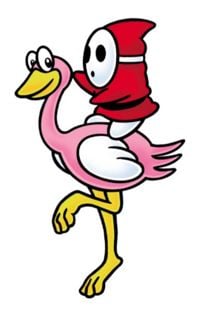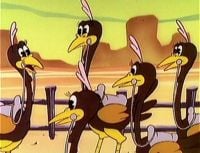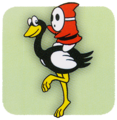Ostro
- This article is about Ostro, the ostrich creature in Super Mario Bros. 2. For the boss character mistakenly labeled as "Ostro" in the Super Mario Bros. 2 cast roll, see Birdo.
| Ostro | |
|---|---|
 Official artwork of an Ostro, being ridden by a Shyguy from Super Mario Advance | |
| First appearance | Yume Kōjō: Doki Doki Panic (1987, overall) Super Mario Bros. 2 (1988, Super Mario franchise) |
| Latest appearance | Super Mario All-Stars Limited Edition (2010) |
Ostros are large, flightless birds from Yume Kōjō: Doki Doki Panic and Super Mario Bros. 2, and are said to be a mode of transportation in Subcon.[1]
History[edit]
Yume Kōjō: Doki Doki Panic / Super Mario Bros. 2 / Super Mario Advance[edit]
In Yume Kōjō: Doki Doki Panic Ostros are ridden by red Shyguys that try to steer them towards the player. If their rider is dislodged, the Ostro travels in a straight line. Players can jump on top of an Ostro and ride it across obstacles even if it still has a Shyguy rider. Ostros can be picked up, but they do not bounce when thrown. In Super Mario Advance, they drop hearts when defeated.
While Ostros are black with white wings and legs and red eyes in Yume Kōjō: Doki Doki Panic and Super Mario Bros. 2, subsequent remakes have depicted them as being pink with a white belly, wings that are the same color as their body, orange legs, black eyes and a pink feather on their heads. The original artwork's attributes are mostly true to the original sprites, though they have yellow beaks and legs, as well as a white tuft on their heads. The artwork for the Japanese release of Super Mario USA lacks the feather on the head the original artwork had, and depicts it as having three toes on each foot, unlike the original artwork and real ostriches, which have two. This artwork was retouched for Super Mario Advance, coloring it pink, but retaining the lack of feather and white wings.
In the cast roll of Super Mario Bros. 2, Ostros' and Birdo's names are mistakenly swapped, a mistake that would not be fixed until the release of Super Mario Advance.
The Super Mario Bros. Super Show![edit]
- “Hi-ho, Ostro, away!”
- —Mario, "The Provolone Ranger"
Several Ostros, though usually referred to as ostriches, appear in several episodes of The Super Mario Bros. Super Show!, where they are usually ridden and used to haul motorless vehicles, much like horses. Due to their role, Ostros never have any speaking lines, and usually make honking noises. They first appear in the episode "Butch Mario & The Luigi Kid", where several Ostros are used by Mario, Luigi, Snifits and several other characters as steeds to travel through the Wild West. A wild ostrich appears in "Too Hot to Handle" on the island of Waki-Waki. Mario, Luigi, and Toad ride it to reach Princess Toadstool faster. Like in the game, they are black, but can also be a dark brown color. Additionally, their wings are orange, have pink feathers on their head, and possess a purple saddle, and bridle.
Ostros are featured in the following episodes:
- Butch Mario & The Luigi Kid
- Love 'Em and Leave 'Em
- Brooklyn Bound
- The Fire of Hercufleas
- Too Hot to Handle
- The Unzappables
- The Mark of Zero
- The Ten Koopmandments
- The Great Gold Coin Rush
- The Provolone Ranger
Super Mario Bros. (film)[edit]
Ostros were also given homage in the Super Mario Bros. film, which featured a sign with the word "Ostro" on it.
Profiles and statistics[edit]
Super Mario series[edit]
Super Mario Bros. 2[edit]
- Instruction booklet bio: He serves as a means of transportation in the world of dreams. Shyguys often ride him.[1]
Super Mario Advance[edit]
- Instruction booklet bio: You've nothing to fear if you can separate Ostros from their riders. Their tremendous speed is something to beware. If you knock out of action, hearts will apear.[2]
Perfect Ban Mario Character Daijiten[edit]
| ダウチョ (JP) / Daucho (EN) | ||||||
| Original text (Japanese) | Translation | |||||
| フライ族 | Tribe | Fly clan | ||||
| 警戒心が強く従順 | Disposition | Alert and obedient | ||||
| USA | Game appearances | USA | ||||
| 高速で走り回るダチョウ? マリオUSAに登場するダチョウのようなキャラ。ヘイホーレッドを背中に乗せたまま、猛スピードで走り回る。特に攻撃はしてこないのでこわくはない。アメリカ名をバードーと呼ぶ。[3] |
Ostriches running around at high speed? An ostrich-like character in Mario USA. He runs around at high speed with a red Shyguy on his back. It is not particularly scary as it does not attack. His American name is Birdo. | |||||
Gallery[edit]
Super Mario Bros. 2 artwork
Screenshot from The Super Mario Bros. Super Show! ("The Unzappables")
Names in other languages[edit]
| Language | Name | Meaning |
|---|---|---|
| Japanese | ダウチョ[4][5] Daucho バードー[5][6] Bādō |
Anagram of「駝鳥」(dachō, ostrich); possibly a reference to "gaucho", which in turn may also refer to The Gallopin' Gaucho, a Mickey Mouse short in which Mickey is seen riding a rhea, a flightless bird from the same genus as ostrich Birdo |
| Chinese | 鸵鸵鸟[10] Tuótuó Niǎo |
Partial repetition of「鸵鸟」(tuóniǎo, "ostrich") |
| French | Autruche |
Ostrich |
| German | Ostro |
- |
| Italian | Birdo[7] Struzzo (The Super Mario Bros. Super Show!) Strutzo[8] Ostro[9] |
- Ostrich Pun on struzzo ("ostrich"); coincidentally, the plural form of "Strutzo" is "Strutzi", the Italian name of Birdo. - |
| Spanish | Avestruz |
Ostrich |
| Swedish | Strutso |
Male form of struts ("ostrich") |
Trivia[edit]
- The Super Mario USA arc of the Super Mario Kodansha manga interestingly refers to Ostro as "Birdo" in Japanese, reflecting its erroneous name from the English credits of the game. This is possibly due to the enemy not being featured in the Japanese manual for Super Mario USA under its official Japanese name.
- Inversely, Birdo is referred to by her proper Japanese name of "Catherine" on the same page.
References[edit]
- ^ a b "He serves as a means of transportation in the world of dreams. Shyguys often ride him." – Nintendo (1988). Super Mario Bros. 2 instruction booklet. Nintendo of America (American English). Page 26.
- ^ Nintendo (2001). Super Mario Advance instruction booklet. Nintendo of Europe (British English). Page 12.
- ^ (1994). Perfect Ban Mario Character Daijiten. Shogakukan (Japanese). Page 103.
- ^ Nintendo (1987). Yume Kōjō: Doki Doki Panic instruction booklet. Nintendo (Japanese). Page 34.
- ^ a b (1994). Perfect Ban Mario Character Daijiten. Shogakukan (Japanese). Page 225.
- ^ Kazuki, Motoyama. Volume 18 of the KC Deluxe manga. Page 6.
- ^ Super Mario Bros. 2 Italian manual, pag. 26
- ^ Nintendo (2001). Super Mario Advance European manual. Nintendo of Europe (Italian). Page 112.
- ^ Super Mario Bros. Enciclopedia. Page 67.
- ^ From the ending scenes of Super Mario Advance as localized by iQue. 无敌阿尔宙斯 (August 28, 2013). 神游 超级马力欧2敌人官译 Official names for iQue Super Mario 2 enemies. Baidu Tieba. Retrieved February 2, 2017.








